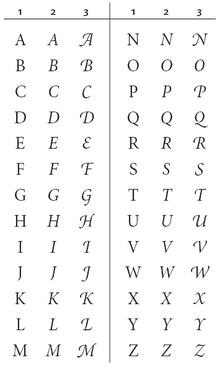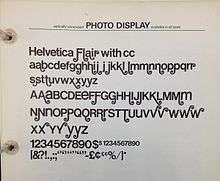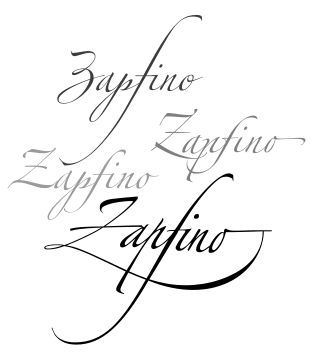Swash (typography)


A swash is a typographical flourish, such as an exaggerated serif, terminal, tail, entry stroke, etc., on a glyph.[1] The use of swash characters dates back to at least the 16th century, as they can be seen in Ludovico Vicentino degli Arrighi's La Operina, which is dated 1522. As with italic type in general, they were inspired by the conventions of period handwriting.[2] Arrighini's designs influenced designers in Italy and particularly in France.[3]
Typefaces with swashes
Most typefaces with swashes are serif fonts, among which (if present) they are often found solely in italics. Advanced digital fonts often supply two italic designs: one with swashes and a more restrained standard italic.
Among old-style typefaces, some releases of Caslon, such as Adobe Caslon, and Garamond, including Adobe Garamond Pro and EB Garamond, have swash designs.[4][5] Old-style typefaces which include swashes but do not follow a specific historical model include Minion by Robert Slimbach and Nexus by Martin Majoor.[6][7]
Among transitional typefaces, Baskerville's original design has swashes on J, N, Q and T. Some revivals remove these, while others may add more. Mrs. Eaves has a particularly large number.[8]
Didone fonts with swashes include Surveyor and ITC Bodoni.[9][10]

Sans-serif fonts with swashes are much rarer. Classiq by Yamaoka Yasuhiro, based on Garamond, contains swash italic designs, as do Goudy's Sans Serif Light Italic and Mr Eaves, a sans-serif derivative of Mrs Eaves.[11] Helvetica Flair, a redesign of Helvetica with swashes by Phil Martin, is considered a hallmark of 1970s design, and has never been issued digitally. It is considered to be a highly conflicted design, as Helvetica is seen as a spare and rational typeface and swashes are ostentatious: font designer Mark Simonson described it as "almost sacrilegious". Martin would later recall being accused of "typographic incest" by one German writer for creating it.[12][13]
As swashes are based on period handwriting, script typefaces with swashes are common, and include Zapf Chancery and Zapfino, both by Hermann Zapf.
Some historical revivals add optional swashes to designs that did not originally have them to produce a more varied design. For example, Adobe Garamond Pro's swash design is based not on the printing of Claude Garamond himself but on designs by his younger contemporary Robert Granjon.[14] The original Caslon italic had swashes only on the letters JQTY; others have been added since by revivals of his designs.[15]
References
- ↑ Henry, Frank S (1917). Printing: A Textbook For Printers' Apprentices, Continuation Classes, And For General Use In Schools. New York: John Wiley & Sons, Inc. p. 82.
- ↑ Adobe Type Library Reference Book (3 ed.). Adobe Systems. 2007.
- ↑ Lawson, Alexander (1990). Anatomy of a Typeface. David R. Godine. p. 91. ISBN 978-0-87923-333-4.
- ↑ "Adobe Caslon glyph list" (PDF). Adobe.
- ↑ Duffner, Georg. "EB Garamond: Features". Retrieved 30 August 2014.
- ↑ "Minion" (PDF). Adobe Systems. Retrieved 30 August 2014.
- ↑ Majoor, Martin. "My Design Philosophy". Retrieved 30 August 2014.
- ↑ Wolson, Andrew. "Baskerville". Font Slate. Retrieved 1 September 2014.
- ↑ "Surveyor: Overview". Hoefler & Frere-Jones. Retrieved 1 September 2014.
- ↑ "ITC Bodoni 72 Swash Book Italic". MyFonts. Linotype. Retrieved 1 September 2014.
- ↑ Yasuhiro, Yamaoka. "Classiq". YOFonts.
- ↑ Simonson, Mark. "Interview with Phil Martin". Typographica. Retrieved 30 August 2014.
- ↑ Puckett, James. "Helvetica Flair (photo of specimen book)". Flickr.
- ↑ "Adobe Garamond Pro" (PDF). Adobe. Retrieved 30 August 2014.
- ↑ Berkson, William. "Reviving Caslon". I Love Typography. Retrieved 21 September 2014.
